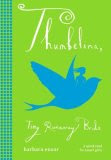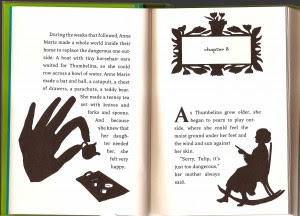Cinderella (As If You Didn't Already Know the Story) Barbara Ensor
The cover also claims that this is "a quick read for smart girls." And it is. It's a pretty straight-forward telling of Cinderella, stretched into 112 pages and heavily illustrated with paper cut-outs.
I really liked Ensor's Thumbelina: Tiny Runaway Bride. But this one didn't resonate with me the same way. I wanted a little more from it. The voice and the use of paper cut-out illustrations reminds one of a less-whimsical Lauren Child. There's a slight snark there that I think, if it had been brought out more, could have made this book really hilarious and something very awesome.
Not that there's anything wrong with it as it is. It's perfectly lovely. I especially liked that there was a chapter AFTER the Prince finds her and a little bit about variations on the story from around the world. But, in the end, it's a very basic Cinderella without much added to it.
I do like the cut-outs though.
Book Provided by... my local library
Links to Amazon are an affiliate link. You can help support Biblio File by purchasing any item (not just the one linked to!) through these links. Read my full disclosure statement.
Viewing: Blog Posts Tagged with: barbara ensor, Most Recent at Top [Help]
Results 1 - 4 of 4
Blog: Biblio File (Login to Add to MyJacketFlap)
JacketFlap tags: Fiction, Fairy Tales, Juvenile, Barbara Ensor, Add a tag
Blog: Children's Illustration (Login to Add to MyJacketFlap)
JacketFlap tags: paper, Barbara Ensor, meet the artist, Add a tag
Blog: The Well-Read Child (Login to Add to MyJacketFlap)
JacketFlap tags: thumbelina, Schwartz and Wade Books, barbara ensor, middle grade fiction, Add a tag
 Thumbelina: Tiny Runaway Bride by Barbara Ensor
Thumbelina: Tiny Runaway Bride by Barbara Ensor
Reading level: Ages 9-12
Hardcover: 160 pages
Publisher: Schwartz & Wade (May 13, 2008)
Language: English
ISBN-10: 0375839607
ISBN-13: 978-0375839603
Thumbelina: Tiny Runaway Bride by Barbara Ensor is a contemporary spin on the classic tale of the tiny girl, Thumbelina. The book begins showing Thumbelina's mother, Anne Marie, who is desperate for a child handing over her life savings to a witch. Anne Marie gets her child, and as we all know, this child is so small that her mother names her Thumbelina.
As Thumbelina grows, we see that her mother becomes extremely overbearing and overprotective. She reads Thumbelina's diary, edits her spelling and grammar, and writes her own comments to her daughter's private thoughts in the diary itself. Thumbelina is a bit spunky and longs to go outside on her own and to have a bit of freedom. When her mother reluctantly grants her wish, she is carried off by a mother toad, looking for a bride for her son. The rest of the story chronicles Thumbelina's escape from the toad and her adventures that follow.
Scattered throughout the book are inkblot illustrations that resemble the Rorschach inkblot test. Thumbelina's messy handwritten diary entries with sentences and words crossed out are endearing and look like many of my own diary entries when I was that age. Tweens will relate to Thumbelina's desire to have a bit of freedom and will enjoy this lighthearted and fast-paced book with an unconventional ending.
Kids who enjoy this book may also enjoy Barbara Ensor's Cinderella (As If You Didn't Already Know the Story).
What other bloggers are saying:
Biblio File: "A nice retelling of a fairy tale that gives Thumbelina back her spunk without detracting from Anderson's original." (Read more...)
Do you have a review of Thumbelina: Tiny Runaway Bride? If so, leave a comment with your lin
Blog: Writing and Ruminating (Login to Add to MyJacketFlap)
JacketFlap tags: book reviews, poetry friday, anthologies, lithgow, Add a tag

If you were to read the table of contents, you would think that this 280-page book contained fifty poems, one each by fifty poets (organized alphabetically by author's last name: Matthew Arnold through William Butler Yeats). And while that sounds like the premise and is, in fact, what is on the accompanying CD: 50 poems, 1 each by the poets listed in the book; it is not all that is there.
Each poet is introduced in a family-friendly sanitized kind of way by Lithgow's prose, and then the "featured" poem is introduced. What do I mean by sanitized? Well, Byron is pretty much just referred to as racy, and Lewis Carroll is described as a kindly man who regretted that children had to grow up so quickly, when most people will tell you that he enjoyed the company of little girls and regretted that they had to grow up at all (and not for Peter Pan-like reasons, I think).
After each poem, Lithgow shares his personal response to the poem, including any personal connections he has (after "Birches" by Robert Frost, he shares an anecdote about hanging from a tree by breaking rope when he was a child, for instance. In addition, for each poet, Lithgow provides a sidebar listing five other favorite poems by the poet (with the following exceptions: he lists only 4 additional poems for Byron and Pound, and lists 6 for Coleridge, Herrick and Shakespeare; he also includes lyrics from one song by Wm. S. Gilbert, who gets nothing more).
And for many poets, although certainly not all, a second poem is included. Not that you'd know that from the table of contents, although for the life of me I don't understand the omission. And not that you can readily figure it out from the index because there is not index. I can understand the decision to skip an index because of the way the book's organized. There's no effort at chronology here, it's alphabetized by the poet's surname after all. But that's all the more reason that the second poems should have been listed under the poets' names in the table of contents. And yes, little things like this actually bother me in real life. (For example, the table of contents tells you that William Blake's "The Tyger" is there, but doesn't mention that "The Lamb" is also included. It tells you that Keats's "To Autumn" is in the book, but not that "The Belle Dame Sans Merci" is there as well.)
From time to time, there are text boxes with additional information — a quote from the poet, perhaps, or a definition of a poetic form, or a link to someplace on the internet where you can hear the poet reading their own work.
What can I tell you about Lithgow's choices? Well, many of them are, for want of a better word, obvious, and cause me to think that Lithgow is fond of reading anthologies himself, since so many of his choices are widely-anthologized. Here's a sampling of what's there, most of which you've probably heard before, and many of which are in anthologies (including anthologies for children): "The Tyger" by William Blake, "We Real Cool" by Gwendolyn Brooks, Sonnet 43 ("How do I love thee?") by Elizabeth Barrett Browning, "Jabberwocky" by Lewis Carroll, "There is no Frigate like a Book" by Emily Dickinson, Pied Beauty by Gerard Manley Hopkins, "To Autumn" by John Keats, "The Owl and the Pussycat" by Edward Lear, "Annabel Lee" by Edgar Allan Poe, "To a Skylark" by Shelley, "The Emperor of Ice Cream" by Wallace Stevens, "Do not go gentle into that good night" by Dylan Thomas, "The Red Wheelbarrow" by W.C. Williams, "I wandered lonely as a cloud" by Wordsworth, and "The Lake Isle of Innisfree" by Yeats.
And yet, it's clear to me that Lithgow simply chose to feature some of his favorite poems, because of the occasional unexpected choice — such as the lyrics to "The Nightmare Song" by William S. Gilbert — and because of the decisions he made regarding "what to leave in, what to leave out".* He's included Allen Ginsberg, Hart Crane, Randall Jarrell, Ben Jonson, Philip Larkin, and Andrew Marvell. Don't get me wrong, all of them are excellent poets, but they are not nearly so widely anthologized as some of the others, nor are they as esteemed as some of the poets omitted: Robert Browning, say, or Ted Hughes or Sylvia Plath (although their estates are stingy with permissions, so perhaps that was the issue), or Tennyson or Pablo Neruda.
As I mentioned near the top of the post, the book is accompanied by a CD featuring readings of 50 poems, 1 per poet. The readings are each introduced by John Lithgow, who reads several of them himself (and takes on an increasingly obvious mock-English accent in the reading of the Gilbert lyrics). But he managed to get some "friends" to assist. They are Eileen Atkins, Jodie Foster, Gary Sinise, Glenn Close, Helen Mirren, Morgan Freeman, Billy Connolly, Robert Sean Leonard, Lynn Redgrave, Sam Waterston, Kathy Bates, and Susan Sarandon. Let me just say that Billy Connolly's reading of "To a Mouse" by Robert Burns is spectacular, as is his version of "The Owl and the Pussycat" and, oh hell, everything else he reads. I'd probably like to listen to him read the phone book. I heart Billy Connolly and his voice. But I digress. Jodie Foster's readings are glorious, and so are Susan Sarandon's and Gary Sinise's and Morgan Freeman's and Kathy Bates, well, if you think I'm going to list everyone, then you're close. There's an occasional track that's only so-so ("Annabel Lee" as read by Sam Waterston, for example), but really, the CD is great. Only you should be warned that the CD is in MP3 format, which meant that my stereo balked at playing it, although yours might not. The computer had no such issue.
So, what's my final take on this book? It contains, after all, so many poems that I already have in other anthologies. And the failure to list the supplemental poems, where they exist, is maddening. And yet, I find myself heartily in favor of it for the simple reason that I believe it might actually introduce the joy of poetry to a lot of folks who might not often shop for poetry books, simply because kindly, professorial John Lithgow is smiling at them from the cover, and assuring them that all will be well. Plus, I love the performances on the CD. Plus, I love poetry anthologies myself. And some of the poems I've been telling you are "obvious" choices are ones I've made myself to feature for Poetry Friday posts. (Oh, glass houses!)
The holidays are coming, folks: Chanukah starts on Tuesday night, December 4th, and Christmas is, as ever, on the 25th. Someone you know may like The Poets' Corner as a gift, although if the someone is a child, then consider the Caroline Kennedy book instead. Or if they're particularly young, go with Here's a Little Poem, edited by Jane Yolen.
*"what to leave in, what to leave out" is from "Against the Wind" by Bob Seger and the Silver Bullet Band






Another intriguing book. I look forward to having an older kid so I can get away with reading them all....I have so much on my list right now!